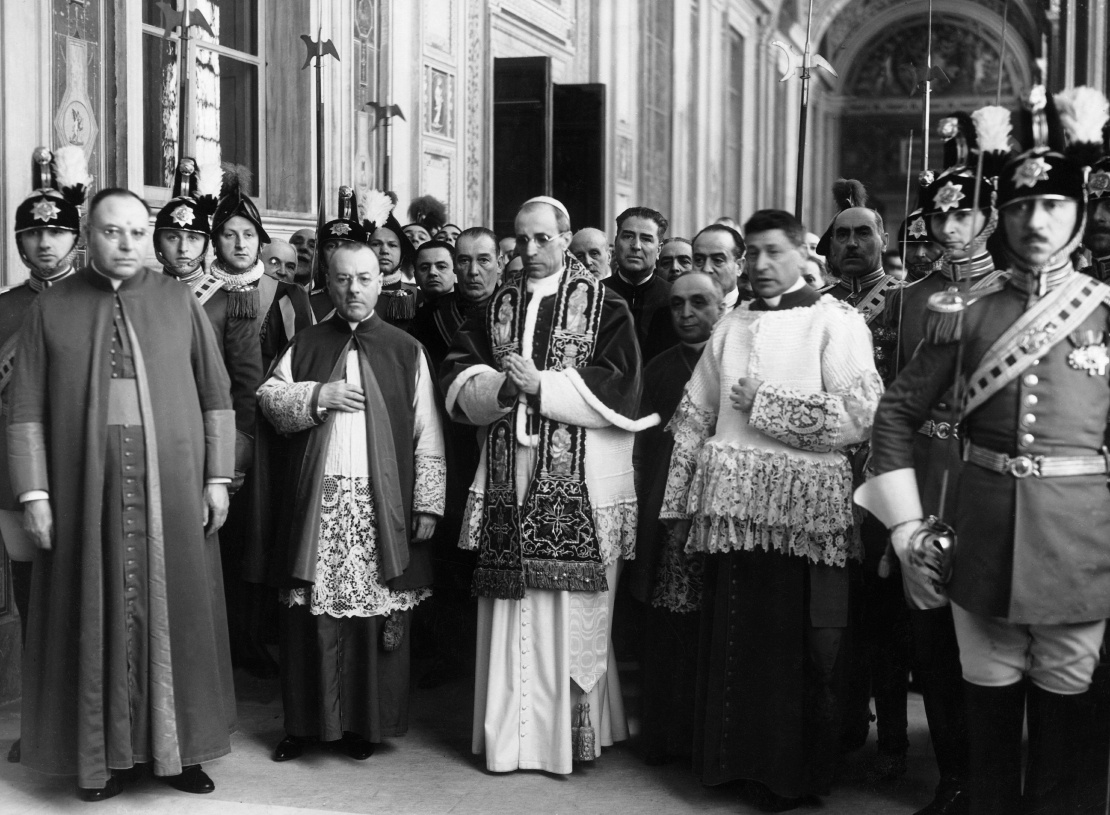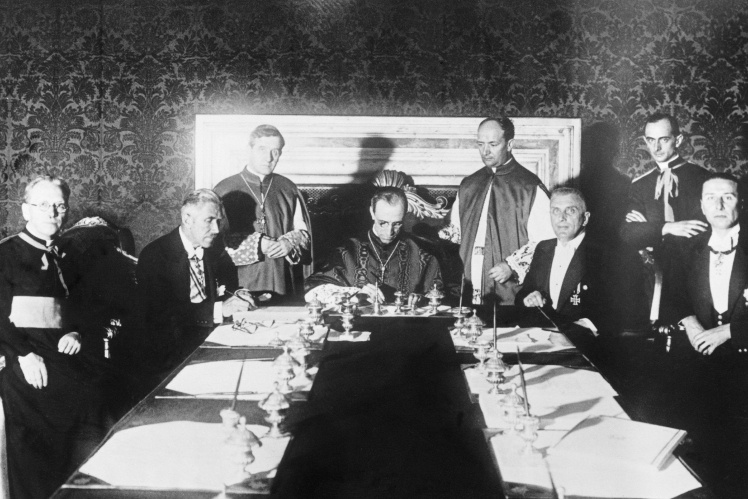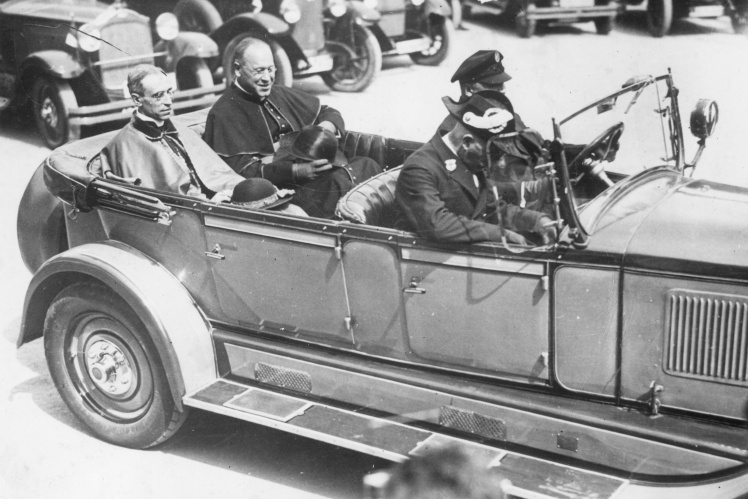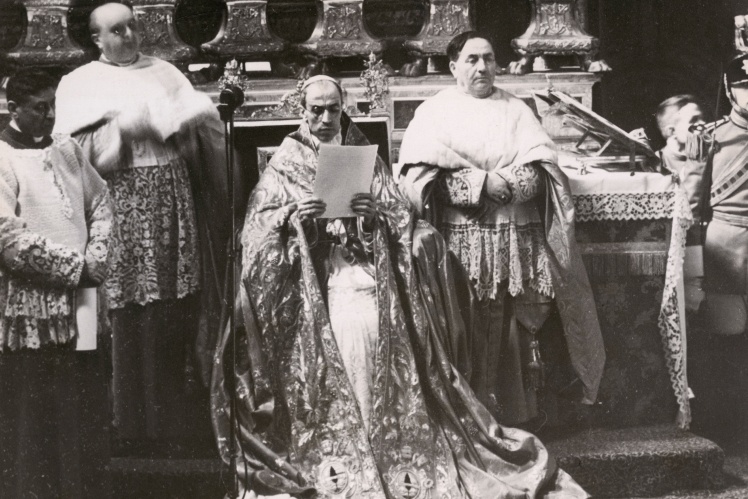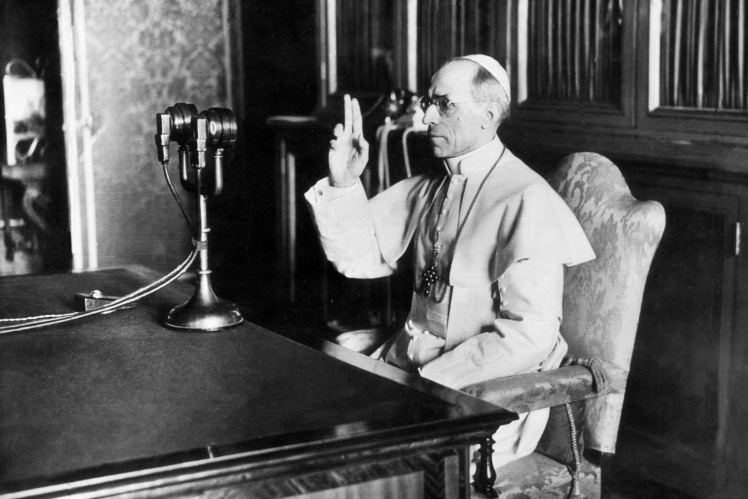On the eve of World War II, the Vatican called for concessions to Nazi Germany. On March 2, 1939, Cardinal Eugenio Maria Giuseppe Giovanni Pacelli became the new Pope under the name of Pius XII.
Already in April, the new pontiff offered peace talks, hoping to act as a mediator between the major European powers on the brink of war. He first contacted the leader of the Italian fascists, Benito Mussolini. And only after his approval did the Vatican send proposals for talks to Paris, Berlin, London. and Warsaw.
Eugenio Pacelli, surrounded by cardinals and the papal guard on the day he was elected new pontiff, March 2, 1939.
Getty Images / «Babel'»
Since 1938, France and Britain have made concessions to Hitler. They first agreed to occupy Austria, and then effectively forced Czechoslovakia to cede the Sudetenland to Hitler to prevent a major war in Europe.
The Vaticanʼs strategy in the new peace talks was roughly the same — to satisfy another territorial whim of the Nazis. Now the Pope has tried to put pressure on Poland to support the city of Danzigʼs accession to Germany. However, the Polish government and the Polish ambassador flatly refused, so the negotiations came to a standstill.
Already after Germany captured Poland, Pius XII tried to initiate new peace talks. He hoped that Hitler would stop there and that the war would not spread to Western Europe. He was wrong again. In 1940, there was still some opposition in Germany. And its representatives tried to contact the British through the Pope. However, the pontiff acted hesitantly, so nothing good came of it. The Vatican then declared that it "does not interfere in secular affairs and territorial disputes".
Papal procession of Pius XII in Rome, 1939.
Getty Images / «Babel'»
The Vatican held secret talks with Nazi Germany. Pius XIIʼs predecessor Pius XI was a real headache for Adolf Hitler. He categorically and publicly condemned Nazi politics and ideology. In 1937, he issued an official letter opposing Nazi persecution of the church, and stated that he could not tolerate the glorification of the pagan swastika. A year later, when Hitler visited Rome, Pius XI demonstratively left the city and went to his summer residence.
Pope Pius XI shortly after his election as head of the Roman Catholic Church on February 25, 1922.
Getty Images / «Babel'»
In contrast, Eugenio Pacelli before becoming pontiff was the official representative of the Vatican in Germany for about 20 years. During this time he really fell in love with this country. His housekeepers, cooks, cleaners, drivers, and personal secretaries were Germans. He even gave his favorite canary a typical German name Gretel. In 1933, Pacelli signed an agreement with the Third Reich on behalf of the Vatican, which gave the Catholic Church some freedom in the country, but banned all Catholic political organizations. So the Nazis got rid of other opponents on the way to conslidating power.
Eugenio Pacelli signs an agreement between the Vatican and Germany on May 25, 1933. Vatican Ambassador to Germany Eugenio Pacelli arrives in Freiburg in 1929.
Getty Images / «Babel'»
When Pacelli was elected the new pontiff, Hitler decided to play on his ties with Germany and establish relations with the Vatican. The talks were so secret and delicate that even the Vatican ambassador to Germany didnʼt know about them. And the main mediator between Hitler and the Pope was the Nazi aristocrat Philipp von Hessen. The pope first met with Hitlerʼs envoy on May 11, 1939. A secret meeting took place in the pontiffʼs secretaryʼs apartment.
Over the next few years, Pius XII and von Hessen met several more times, exchanged letters, and tried to reach a compromise between the Nazis and the Catholic Church. At first, things went well, the Nazis even made a "gesture of goodwill" — banned criticizing Catholic priests in German press.
Philipp von Hessen (right) on the day he was appointed governor of the province Hesse-Nassau, 1933.
Getty Images / «Babel'»
After the attack on Poland, Hitler hoped to establish new official relations with the Vatican. And the Pope went to meet him, agreeing to receive German Foreign Minister Joachim von Ribbentrop. On the morning of March 11, 1940, von Ribbentrop and his retinue arrived at the papal residence under Vatican and Nazi flags. The minister refused to bow his knee, as was customary when approaching the Pope, but instead dropped his hand in a Nazi salute.
It was in a conversation with von Ribbentrop that Pius XII "expressed the hope" that Germany would be satisfied with the occupation of Poland and end the war. But a few months later, the German army began to move rapidly west, occupying the Netherlands, Belgium, Luxembourg, and France. However, the Popeʼs secret meetings with Hitlerʼs mediator von Hessen continued until the spring of 1941. In the end, no formal agreement was reached following the meetings, and Pius XII never met with the Fuhrer himself.
The future Pope Pius XII leaves the Presidential Palace in Berlin, 1928.
Getty Images / «Babel'»
The Vatican did not publicly condemn Hitler and the Holocaust, but openly opposed communism. Perhaps the most important thing that Hitler managed to achieve in the negotiations with the Vatican was the Popeʼs public "silence regime" regarding the Nazisʼ actions.
This was evident during the meeting of Pius XII with von Ribbentrop. The German minister began to criticize the Popeʼs predecessor for allowing himself to speak harshly against Germany. Pius began to justify himself by saying that in his speeches he had taken care not to offend the Germans in any way. And in the last Christmas address, the mention of the suffering of the "small nation" did not refer to captured Poland, but to Finland, which was attacked by the USSR.
Vatican Ambassador to Germany Cesare Orsenigo (left) with Adolf Hitler (center) and Joachim von Ribbentrop (right) at a New Yearʼs Eve reception in Berlin in 1939.
Getty Images / «Babel'»
In general, during World War II, Pius XII never publicly criticized the crimes of the Nazis and didnʼt actually call them criminals. In his Christmas address of 1942, the pontiff only veiledly mentioned "hundreds of thousands of people who were doomed to death or successive extermination without any guilt, and sometimes only because of their nationality or race". The Vatican would later say that the church could not publicly condemn the Holocaust for fear of even greater Nazi repression.
However, according to people close to the pontiff, in private conversations the Pope called the Nazis "servants of the devil" and said that "Hitler went finally mad". And one of his secretaries even mentioned that Pius XII twice performed an exorcism over Hitler, claiming that "the absolute evil embodied by the Fuhrer could not come from human nature".
Pope Pius XII reads a speech, 1940. Radio address Pius XII, 1942.
Getty Images / «Babel'»
As for communism and the Soviet Union in particular, Pius XII never restrained himself in harsh statements. He refused to officially bless the German invasion of the USSR in 1941 — however, in his speeches during the war, the pontiff condemned the Communists more than 150 times, calling them "enemies of God" and "hellʼs brood". As a barrier against communism, he saw not only the dictatorial regimes of Hitler in Germany and Mussolini in Italy, but also Francisco Franco in Spain and Antonio Salazar in Portugal. In the autumn of 1941, the American president asked the pope for advice on whether the United States should help the Soviet Union in the war against Germany, given its rhetoric. However, the Vatican assured that this applies only to the Kremlinʼs communist elite, and "Pius XII has exclusively paternal feelings about the Russian people themselves".
Catholic priests secretly hid Jews, but also helped Nazi criminals escape. During the war, the Catholic Church did save thousands of Jews. They were secretly hidden in monasteries, given certificates that they are baptized into Catholicism. The pope protested the deportation of Jews to the governments of Hungary and Bulgaria. And during the Nazi occupation of Rome, with his help, about five thousand Jews were saved. Then the pontiff opened his country residence to the fugitives.
One of the most active Catholic priests who saved Jews and Allied soldiers was the Vatican priest of Irish origin Hugh OʼFlaherty. He set up a real network of undercover agents, squatters and shelters under the Nazisʼ noses. Thanks to this, more than 6.5 thousand people were saved. The Gestapo set a reward for the head of the underground priest, but they were unable to catch him.
Catholic guerrillas with a portrait of Pius XII and a poster in his honor in Rome liberated from Nazis. July, 1944.
Getty Images / «Babel'»
However, with the help of the Catholic clergy, thousands of Nazis and collaborators also escaped justice. The escape routes called by the US intelligence services "rat trails": through the Alps to Italy, where to stay in some inconspicuous monastery, and from there to escape by sea to South America. To escape from Europe, a displaced personʼs ID card issued by the International Committee of the Red Cross was required. It was dangerous for the Nazis to apply to the Committee with their real passports. However, with only a letter of recommendation from the Catholic Church, obtaining a passport from the Red Cross was easy enough. The Vaticanʼs reputation worked here.
Passport issued by the International Committee of the Red Cross in the fictitious name of the Nazi criminal Adolf Eichmann. With this document he fled to Argentina in 1950.
Getty Images / «Babel'»
Some Catholic priests helped German officers out of "Christian love of neighbor". However, there were those such as Bishop Alois Hudal, who supported the policies of the Third Reich and did not hide his anti-Semitism. In the spring of 2020, the Vatican declassified more than two million of its own World War II documents. Working with them, researchers are trying to find an answer to one of the controversial questions — whether Pius XII himself knew about the existence of "rat trails" used by the Nazis.
Pius XII received American soldiers and journalists shortly after the liberation of Rome in July 1944.
Getty Images / «Babel'»
Translated from Ukrainian by Anton Semyzhenko.
We hope that the Vatican will one day be able to truly support Ukraine and condemn the aggressor — Russia. And you can support Babel right now: donate in hryvnia 🔸 in cryptocurrency 🔸 PayPal: [email protected].

